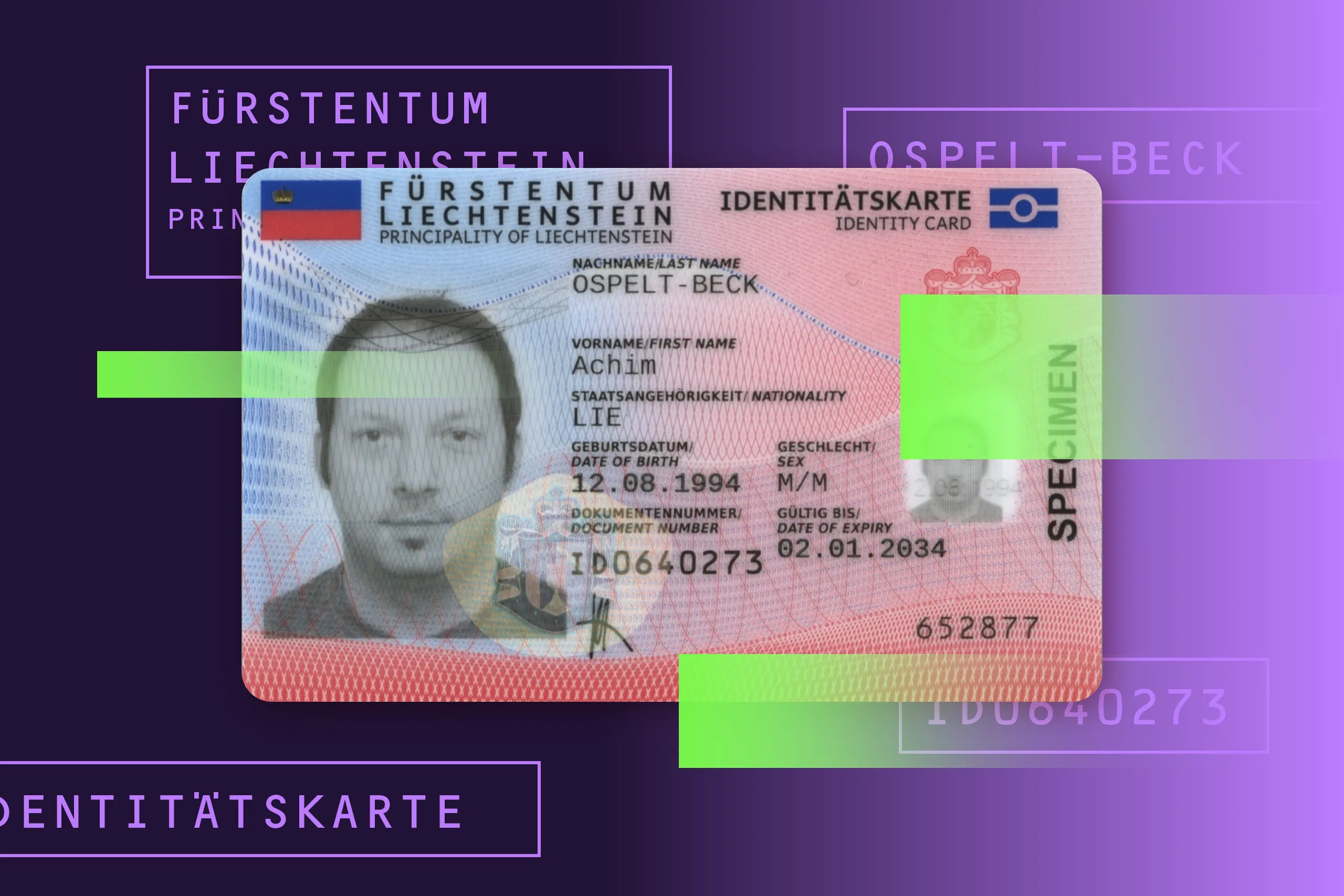Back in the day, border officers had to input data manually. This process sparked the question: could there be a more efficient method? The first ID document readers appeared as an answer to this plea—to give officers a hand at manual data entry. Their capabilities have since significantly advanced.
This post aims to help your organization make the right choice of ID reading devices that minimize investment risk and align with your current and long-term objectives.
What’s a document reader?

Regula 70X4M, an example of a document reader
A document reader is basically a device equipped with specialized optics and software. Both components are crucial: one cannot function effectively without the other. With the spread of electronic documents, a module for reading RFID chips has been added to the mix.
Here's how it works:
Image Capture: The document reader takes pictures of an ID document using various light sources. It also reads the document’s chip if there’s one present.
Data Extraction: The software recognizes and extracts the relevant data.
Verification (can be optional): The extracted information goes through a rigorous check to confirm both the document’s authenticity and the accuracy of its details. This process includes verifying if the ID matches its template, if the information aligns across different sources, if the format of document elements is correct, and more. As the demand for Know Your Customer (KYC) protocols increases, the verification step is tending to shift from a nice-to-have feature to a must-have.
We talked about this in detail in How Do ID Scanners Work and What Are They Good For?
Get posts like this in your inbox with the bi-weekly Regula Blog Digest!
Three stages of ID document reader evolution
Establishing standards was essential to streamline the processing of identity documents. The International Civil Aviation Organization (ICAO) laid the groundwork with the creation of ICAO Document 9303, a comprehensive guide on machine-readable documents. This guide set forth requirements for the documents countries must issue for use in civil aviation, shaping the future of ID document design and their security features.
While these requirements primarily target ID documents, they indirectly inform the manufacturers of document readers of the recommended capabilities necessary for automating the document reading and verification process. (You can find the details in ICAO Doc 9303 part 2, C.4.2 Manufacturer of Full Page Reader)
Here’s how these guidelines have gradually influenced the evolution of document readers.
MRZ reading
The initial phase of document reader evolution focused on data entry automation and accelerating the work of border control officers. It was driven by ICAO’s push for machine-readable documents and standardization of the machine-readable zone (MRZ), which became a must for any ID to be accepted in civil aviation.
In 2015, ICAO decided that all documents should be machine-readable, and issued specific requirements, such as a passport to be 125x88 mm, what a data page should be like, and more. This paved the road for document reader manufacturers to make devices that could read MRZs (and later other data sources) and automatically enter the data into databases.
Examining IDs under different light sources
The capability to verify documents under multiple light sources marked the next stage of evolution, aiming to further simplify border control operations. This advancement led to the incorporation of white, ultraviolet, and infrared light sources in ID document readers, allowing for more comprehensive document verification.
Document authentication
The third stage in the evolution of document readers is a significant leap towards enhancing security measures: the capability to authenticate ID documents. This advancement is poised to become a cornerstone for future document reader functionality, focusing on not just reading, but also verifying document authenticity.
The question is, how should they do this?
Let’s have a closer look at what exactly makes an ID document reader a future-proof solution with reliable performance all along the way.
What a modern document reader is like
All the requirements for document readers can be conditionally divided into two groups:
Requirements for the physical device
Requirements for the software that controls the device
It goes without saying that document readers should be convenient, easy to use, and reliable—just like any equipment intended for use by people. However, the main technical requirements for the device itself are relatively simple: light sources and a high-resolution camera must be available. Everything else depends on the software, which will analyze the images captured by the document reader. But first things first.
#1 Availability of light sources
A fundamental feature, the availability of white, ultraviolet (UV), and infrared (IR) light sources, has remained crucial over the years. At the same time, the use of additional light sources, such as coaxial and oblique light, will allow you to analyze more security features and increase the reliability of document verification. Neutralization of glare also comes in handy to improve reading and analysis of personalized document data.
#2 Quality optics
The document readers of tomorrow should be able to detect counterfeiting by analyzing printing methods. Without this, it is difficult to perform fully automatic document verification. The effectiveness of a device in detecting counterfeiting efforts significantly depends on its optical capabilities.
For now, the market average optical resolution of ID document readers is 400 dpi (dots per inch). While the current standard, according to Doc 9303, is between 385 dpi to 600 dpi, you need to take the upper value as a benchmark. The thing is that modern ID documents often include security features that are only visible in high resolution, i.e., more than 400 dpi (e.g., microtext, Guilloches, etc.).
To effectively authenticate documents, the industry target is to have a resolution of 1000 dpi or more in the near future.
# 3 NFC reading
Earlier document readers only read the MRZ, but today that’s not enough. Most modern passports have an RFID chip—making them “electronic”—which securely stores the data about the document issuer as well as the personal data of the holder. The ability to read this chip is now a key feature for ID document readers, allowing for more secure and advanced verification of documents and the identities of their holders.
# 4 The use of AI
AI engines, trained with a vast array of document samples, can automate the recognition of different printing techniques. Although the staff in control has the final say, these capabilities help them assess whether a document is genuine or fake much faster, but still accurately.
A critical factor here is the vendor’s depth of ID document knowledge, and the breadth of their sample database. Without these, the principle of “garbage in, garbage out”—a fundamental rule of AI training—takes effect, potentially compromising the system’s effectiveness.
# 5 Fast performance
Efficiency is also measured by time, because it’s important for the people in control to carry out document checks quickly. The standard expectation is that a document reader should read a document and provide an analysis within 2-3 seconds. Anything over 5 seconds is seen as too slow for today's fast-paced requirements.
To sum it up
The use of document readers has expanded beyond governmental applications to include various sectors in the civil domain. Their function has also evolved from mere document reading to a more complex role in ensuring the authenticity and integrity of documents.
Take notaries, for example. A simple document reader is sufficient to fill out their certificates automatically. However, they still need to check the ID document for authenticity, because otherwise, they can notarize a document for an imposter, which is a misdemeanor offense.
Effective document verification is essential for banks when onboarding new customers, not only to reduce their risks when they issue loans, but also to comply with current regulations.
Сasinos also need proper ID verification. First of all, they must ensure that only adult players get in. Plus, if a client wins, they have to report it to the IRS, which imposes the additional importance of making sure the IDs are legit.
Even for hotels, which, in theory, don’t care that much about the authenticity of ID documents, there are reputational risks if it turns out that some criminal accessed their facilities using forged documents.
Of course, not every business needs to check document authenticity now, but the chances are regulatory tightening could expand this requirement to more industries at any time. So, when looking for a future-proof solution, the capability to help you instantly detect fake IDs is key.
Regula has been at the forefront of document authenticity verification for over three decades. If you’d like to learn more about what type of ID document readers can better serve your goals, or how to build an effective verification pipeline, feel free to consult with the experts from Regula.





